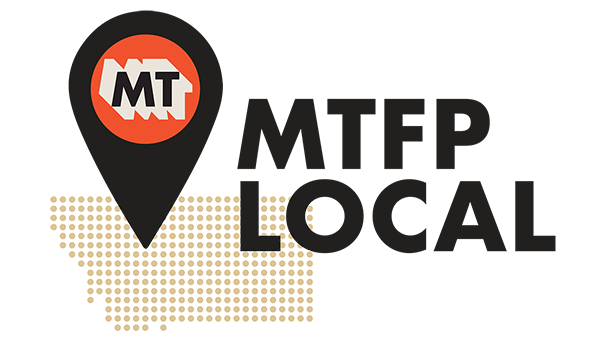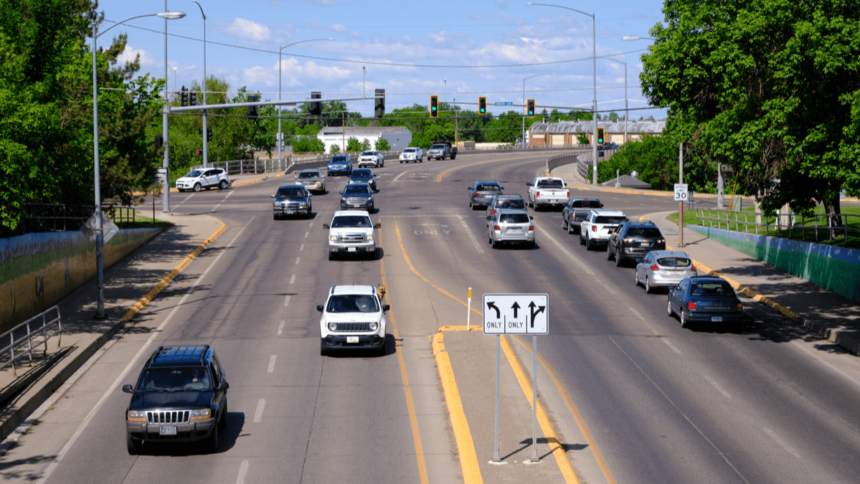A multi-agency effort is underway to develop the latest long-range transportation plan for Great Falls, which was last updated in 2018.
Drivers shouldn’t expect major changes coming from this effort. Great Falls and Cascade County are seeing nearly flat growth trajectories, which is a departure from Montana’s other largest counties. Thus, the top-line goal for the 2024 plan is the preservation and maintenance of the existing transportation system.
“That’s definitely a little bit unique to the Great Falls area,” said Scott Randall, the consultant project manager for the plan. “It’s had a more slow and sustained growth.”
But that doesn’t mean the city lacks projects and initiatives. Designs are being developed for a major interchange reconstruction, and there is a growing focus on building a “multimodal transportation system,” which includes accessibility improvements, cycling infrastructure, and public transportation options.
The long-range transportation plan is a product of the Great Falls Metropolitan Planning Organization, which involves local, state, and federal governments, as well as special jurisdictions like the Great Falls Transit District. Randall is the project manager from the Helena firm Robert Peccia and Associates. While the plan is periodically updated, its perspective is meant to span decades.
“The first thing here is to make sure we’re thinking about the future and updating things as needs change,” Randall said.
Changing needs might include compliance with federal legislation that can fund large portions of transportation projects. Randall said that legislation like the Infrastructure Investment and Jobs Act signed by President Joe Biden in 2021 can tweak the criteria that make projects eligible for federal transportation funding. Updates to the local plan include checks to ensure they’re in compliance.
Another part of the update is responding to public input. The Metropolitan Planning Organization held an open house on May 30 at the Civic Center. Visitors walked by a set of maps and informational displays and had the chance to pose questions to Randall and other staff. Many visitors pointed out areas they knew well and talked about issues negotiating certain intersections or streets.
Matthew Ludwig, 28, recently moved to a home near downtown Great Falls. He’s a recreational cyclist but drives to work because he doesn’t see a safe way to ride there. He said his mind is on sustainable transportation options as he considers the impact of more and more vehicles.
“What can I do to make this a safer place for them — my future children?” he said.
Ludwig hopes to see Great Falls adopt policies that promote healthy transportation options as Great Falls grows for the long term. In short, he wants solutions that don’t just add more cars and roadways.
After perusing the displays at the open house, Shyla Patera, 55, took away a holistic view of the transportation issue. She wanted to see in Great Falls a transportation system that encourages ready access to transit, vehicle, walking, cycling, and accessible infrastructure at all times. A bus commute shouldn’t be more difficult than the same trip in a single-occupant vehicle.
“If one mode of transportation isn’t as healthy as another, then you don’t have a well-rounded system,” Patera said.
This is an area of expertise for Patera. She is an independent living specialist by day, but she has been deeply involved in local transportation policy. She currently serves on the Great Falls Transit District Board and has provided input in other public settings for years.
Patera said that changes in the local transportation system are incremental. Funding and public attention often dictate the priority list for improvement projects. Patera, a wheelchair user, said that city officials have done “awesome work” in the past to include the disability community in planning. Patera wants to see resources devoted to accessibility projects like completing sidewalks with ramps.
But for the purposes of this long-range transportation plan, Patera said she encouraged herself and others to look beyond their personal areas of interest and toward the well-rounded approach. So often, she said, residents tend to be most vocal about the issues in their neighborhoods. Patera sees pedestrian and bicycle travel getting more attention in this review.
“If one mode of transportation isn’t as healthy as another, then you don’t have a well-rounded system.”
Shyla Patera, transportation advocate
“I’m really excited to see the non-motorized projects,” she said.
Great Falls installed its first roadside bike lane in 2013, and after more than a decade just 4.1 miles of bicycle lanes exist in the city. A portion of the 2024 transportation plan that’s already published notes a “relative lack” of bicycle infrastructure in the city’s core. This doesn’t include the 60-mile River’s Edge Trail system, which is confined to the banks of the Missouri.
Randall said that the finished long-range plan will have a “pretty big emphasis” on nonmotorized transportation.
The plan also highlights some gaps in Great Falls’s sidewalk network. A 2017 inventory of sidewalks found that 63% of the curb ramps on corners don’t comply with the Americans with Disabilities Act.
Planning documents also identified neighborhoods with the poorest sidewalk connectivity. These include areas along Lower River Road, residential areas just north of the Sun River, and some of the hilly suburban areas west of Flood Road.
Great Falls remains a driving city with more than 90% of commutes taking place in a vehicle, according to planning documents. And while more residents are working from home, that reliance on vehicles remains for short errands.
Given the relatively flat growth trajectory of the area’s population, the volume of travel on the city’s roadways has also remained fairly stable. Studies in 2014, 2018, and 2024 planning documents show this. Residential growth is expected to continue largely on the southern and northern edges of Great Falls.
The biggest roadway project currently underway is at the Gore Hill Interchange, where semi-trucks, airport visitors, residents, and commercial vehicles navigate the ramps off and onto Interstate 15 and Airport Drive. According to plans, the project would install roundabouts at the interchange, add a southbound exit lane going up the hill, and move the Tri Hill Frontage Road to the south of the Pilot travel center.
This project was supported by the 2018 long-range transportation plan, though it could be years before any construction work begins.
The Great Falls MSO hopes to have a draft long-range transportation plan ready for public review this summer. Some preliminary information is already available on the planning website.

In-depth, independent reporting on the stories impacting your community from reporters who know your town.
LATEST STORIES
Future in doubt for Kalispell shelter amid neighborhood complaints
Opponents of the shelter point to an increase in crime in the area since it opened in 2020, but proponents say the warming center shouldn’t be blamed for the Flathead Valley’s homelessness crisis that has grown amid a loss of services and a spike in home and rent prices.
Tester and Sheehy have first debate
In the first debate of Montana’s high-profile U.S. Senate race, Republican challenger Tim Sheehy Sunday repeatedly portrayed America as a country ravaged by problems enabled by Democrats and said he’s part of “new leadership” that can fix things.
His opponent, three-term Democratic U.S. Sen. Jon Tester, said he’s the real Montanan who understands rural America and has used his influence to help the state, and that it’s wealthy outsiders like Sheehy who are making Montana unaffordable and less livable for the average person.
Yellowstone National Park calls for more bison in new plan
The park prepared its new plan in response to research regarding brucellosis, a bacterial disease that can cause cattle to abort their young. That research has concluded brucellosis transmission to livestock — a concern that has underpinned the park’s bison-management approach for more than two decades — is more likely attributable to elk than bison.





